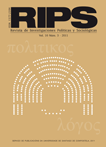Podemos in the Regional Elections 2015: Online Campaign Strategies in Castile and León
Contenido principal del artículo
Resumen
Internet has revolutionized many aspects in the way that political parties communicate. The Network has induced a complete transformation of the political strategies used during election campaigns to spread their message to the electorate. Politicians use social networks and digital platforms to promote their messages and to communicate with citizens during these periods of time. Facebook has proven to be one of the most effective networks in this regard. The party Podemos was born in 2014 in Spain, surrounded by a deep economic, institutional and political crisis. This political party promises to be a real hope to the negative situation of the country. In the recent years, Podemos has aroused the interest of social scientists because of the innovative way they use social networks. This paper explores the cybercampaign strategies that Podemos used during the 2015 Castile and León regional elections, a region where the population is very different from the party’s average voter. To this end, a quantitative analysis of their activity on Facebook and their website was made during the regional election campaign. The results of this study allow us to observe an ordinary use of the digital tools by Podemos that highlights the engagement achieved with users in Facebook.
Palabras clave:
Citado por
10.17979/redma.2024.28.1.10114
10.3145/epi.2020.nov.08







